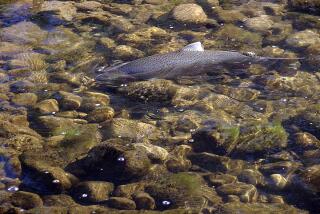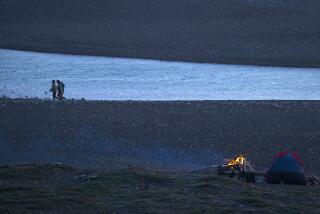Elkhorn Slough, an intimate Monterey Bay wildlife refuge
A sound like a high-pitched screech of a bird rang out over the gray-green pickleweed and muddy shores of the Elkhorn Slough. I looked around and saw an otter, presumably a female, that had lost sight of her pup and uttered the plaintive cry.
It was a February morning in the 1,439-acre saltwater research reserve right at the curve of Monterey Bay. As I paddled along, I came so close I could see the panicked expression on the creature’s face.
The pup, swimming nearby, finally returned the call, and the two were soon reunited in a scene that played out in the middle of a deep channel just 25 yards from the bow of my banana-shaped vessel.
I was out with a group exploring the Elkhorn Slough National Estuarine Research Reserve, about 20 miles north of Monterey near Moss Landing Harbor. The slough has a reputation as one of California’s best locales for watching otters, harbor seals and more than 100 species of birds — and this day didn’t disappoint.
Although several hiking trails bisect the preserve, a kayak is the best way to take it all in.
I joined a young couple from Palo Alto on a four-hour kayak tour led by Matt Gardner, a marine biologist and guide with Kayak Connections. The tour began at a small fishing pier about five miles inland. As the waterway winds its way to the harbor, its shallow fingers branch out like the antlers of an elk, thus the slough’s name. The slough runs under California 1 before draining into the Pacific Ocean.
Since the U.S. Army Corps of Engineers widened the opening and built the harbor in 1947, the slough has been eroding. The tide washes nearly 2 million cubic feet of sediment out to sea each year — the equivalent of 10,500 dump trucks full of dirt. Marine biologists, conservationists and university scientists, concerned that such erosion may turn the salt marsh into mud flats, have been working on a solution for two years.
But any plan to halt erosion likely would block the strong currents — the same ones that make the slough great for paddlers.
My tour, dubbed Ride the Tide, launched near one of the farthest inland spots so we could maneuver through 20- to 30-foot-wide channels to the harbor with relative ease.
Near the pier where our trip started, small white Forster’s terns hovered above the water, eyeing the surface for underwater treats. When they spotted their prey, they collapsed their bat-like wings, turning their bodies into feathered missiles and dive-bombing into the water before coming up with a snack.
Along the shore great egrets, willets and long-billed curlews waded among the pickleweed, scouting out worms, crabs and other crawling morsels.
About two miles into the tour, we paddled to a spot called “seal bend,” where half a dozen roly-poly harbor seals lay on the muddy shores sunning themselves. They barely raised their heads as we passed by.
As we rounded a bend, the tide suddenly kicked up and began pushing us toward the harbor. Wind gusts of 10 mph hit our faces as muddy shores sped past; we were moving at a fast clip.
And the show wasn’t over yet. Black loons swam low in the water, and black-and-white bufflehead ducks dived under the waves in search of food. Overhead, squadrons of Canada geese soared in a tight V-formation.
In the last mile, in a channel nearly 40 feet wide, dozens of otters swam, dived and splashed around us. This was where I witnessed the mother-pup reunion.
Gardner, our laid-back guide, told us about otters being hunted nearly to extinction in the early 1800s by Russian settlers.
Now that has turned around, with about 2,500 otters living along the coast — a colony of about 75 living right here at the slough.
In the final 50 yards to the harbor, white-capped waves were breaking over the bow of my kayak, and Gardner warned that otters that have lost all fear of humans occasionally jump onto passing kayaks, tipping paddlers into the water.
As if on cue, a snout of bristly whiskers swam alongside his kayak and began tugging on the bungee cords tied to the top of the hull. Because it’s illegal to harass a marine mammal, all Gardner could do was watch and be prepared to be capsized.
But the otter was just toying with him. After a couple of half-hearted tugs on the bungee cords, it ducked under the waves and disappeared.
Then the tide carried us to the harbor and the end of our tour.
hugo.martin@latimes.com
More to Read
Sign up for The Wild
We’ll help you find the best places to hike, bike and run, as well as the perfect silent spots for meditation and yoga.
You may occasionally receive promotional content from the Los Angeles Times.






